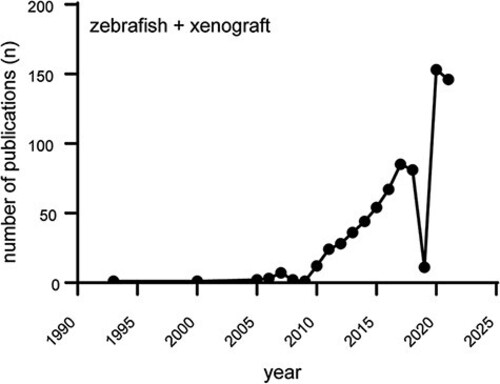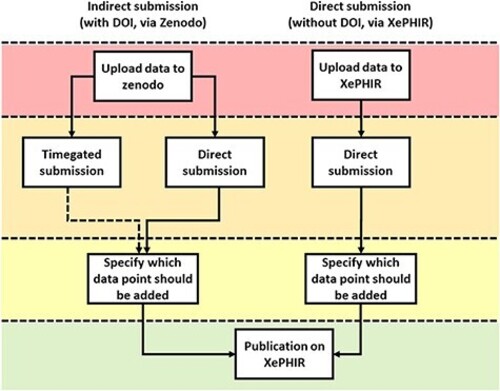- Title
-
XePhIR: the zebrafish xenograft phenotype interactive repository
- Authors
- Groenewoud, A., Forn-Cuní, G., Engel, F.B., Snaar-Jagalska, B.E.
- Source
- Full text @ Database (Oxford)
|
Increasing popularity of the zebrafish xenograft model. Over the course of the last 10 years, the popularity of zebrafish xenograft models has been steadily increasing. Figure based on a https://www.pubmed.gov search for articles containing both the keywords zebrafish and xenograft. |
|
Graphical representation of common injection sites of the zebrafish xenograft model. Injection through the duct of Cuvier, a common route of injection to generate hematogenously disseminated cancer, is also described as an experimental micrometastatic model (10, 11). Perivitelline space injection, originally described as a model for the generation and assessment of angiogenesis, more recently developed as a model for the generation of primary-like tumors (6). Retro-orbital engraftment, used for the generation of orthotopic primary-like tumors derived from eye tumors, allows for the development of distant metastases (12). Hindbrain cavity injection models are used for the generation of orthotopic brain cancer models and for the generation of brain metastasis models (13). Intra-pericardial injection, used for the establishment of primary-like tumors, in an environment closed off from further blood circulation (14, 15). All larvae were injected with ∼200–300, tdTomato expressing cancer cells at 48hpf and imaged at approximately 2 h post-injection using a Zeiss LSM800 laser scanning confocal microscope with an Airyscan detector. |
|
Triple-negative breast cancer sample data as deposited. Image-based analysis data are used to generate a graph for the original publication and are subsequently uploaded to XePHIR (either directly or indirectly). Subsequently, the available metadata is entered during submission (filling in the available data in the submission template). All metadata will be displayed next to the images that have been uploaded, when uploaded via Zenodo a DOI will be provided to allow easy access to the original data set. |
|
Data are derived from redundant image-based analysis. Image-based analysis data are used to generate a graph and are subsequently used for the publication of the original paper, where one representative sample individual is used in the original manuscript. Another representative individual is submitted to XePHIR either directly or indirectly through deposition of the underlying data set in Zenodo and subsequent publication of the representative image in XePhIR. Using the plotted data used for the generation of a figure in a research article allows for the selection of an adjacent, representative individual in normally distributed data. |
|
Methods of data submission to XePHIR. Indirect submission through Zenodo, allowing uploading of whole data sets (after acceptation of publication) will allow for enhanced transparency and reusability of data and will provide the user with a DOI-enabling citation of the data set. Uploading to Zenodo will automatically place the data under a CC license. Direct submission to XePHIR will not provide the user with a DOI and will require the user to place the data under a CC license. |





